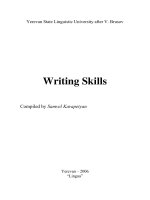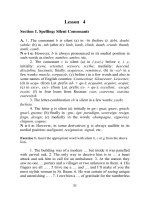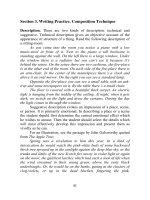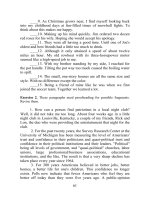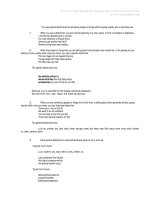Tài liệu Developing writting skills 2 part 3 pdf
Bạn đang xem bản rút gọn của tài liệu. Xem và tải ngay bản đầy đủ của tài liệu tại đây (107.72 KB, 10 trang )
20
Explain what is meant by:
1. After the fire drill was over, we re-entered the building. Now
I raced up the stairs, stepping on the heels of the slowpoke
ahead of me.
2. I was out of my seat in a flash, heading for the teacher’s
desk, when a redheaded girl across the aisle tripped me up.
3. She leaned over me as I lay sprawled on the floor and hissed
in my ear.
4. Slowly I began to erase the troublesome incident from my
consciousness, and my fear began to fade.
5. I came home that afternoon more mixed up than ever but
determined not to stick my neck out.
6. … I fled out the front door in my stockinged feet, going forty
miles an hour, my heart pounding like a jackhammer in my
chest.
QUESTIONS FOR STUDY AND DISCUSSION
1. Comment on the first sentence of the story /part I/. Is it an
effective beginning?
2. Speak on the role of rhetorical questions in the story. What
do they add to the text?
3. Why is the story divided into two parts? Do you observe any
difference between the ways the actions develop in “Gun in
the Desk” and in “Man Overboard”?
4. Point out three sentences in the story that keep you in
suspense.
5. Point out the climax of the story. Account for your answer.
6. Copy out some concrete verbs that do justice not only to the
bare facts of the event but to its “feeling” as well.
7. Look at the first sentence of the last paragraph/part II/: “At
the corner of Main and Maple Streets I ran headlong into
traffic and was almost run over by a cruising police car.”
Would the story be improved by more specific details at this
point? Make up two sentences that would be more specific
than the sentences from the story.
21
8. Comment on the role of direct quotations. Would the
expressiveness of the writing gain or lose if they were
introduced in indirect speech. Why?
9. In the last paragraph of the story, one sentence reads, “In
talking to the detective later, I learned how my unwillingness
to get involved had led to the near death of the armored car
driver.” Would the story have been better if this had been
written out as direct quotation, as a dialogue between the
narrator and the detective? Why?
10. Do you consider the conclusion an effective one. Would you
change anything in it?
EXPAND YOUR VOCABULARY
Match the words from the story in Column A with their definitions in
Column B
A B
1) to scold a) to disappear suddenly and/or
in a way that you cannot explain
2) to stagger b) to make a feeling, an idea, a
memory, come into your mind
3) to stumble c) to warn sb about the possible
dangers or problems of sth
4) to trip d) an act of running or driving
after sb/sth in order to catch
them
5) troublesome e) to remove sth completely
6) to erase f) to walk with weak unsteady
steps, as if you are about to fall
7) to vanish g) the state of being able to use
your senses and mental powers
to understand what is happening
8) to caution h) to hit your foot against sth
while you are walking or running
and almost fall
22
9) to summon up i) to catch sb's foot and make
them fall or almost fall
10) chase j) air that is difficult to see
through because it contains very
small drops of water, especially
caused by hot weather
11) to pound k) to speak angrily to sb,
especially a child, because they
have done sth wrong
12) coincidence l) a long steady look at sb/sth
13) consciousness m) causing trouble, pain, etc.
over a long period of time
14) to glare n) (of heart) to beat quickly and
loudly
15) gaze o) to look at sb/sth in an angry
way
16) haze p) the fact of two things
happening at the same time by
chance, in a surprising way
YOUR TURN
I. Here is an outline of a story written by a student. Read it
over and then try to write the story from the outline.
Imagine the details.
1. I came back from school and found the house empty.
2. “Anybody home?” I called.
3. A strong, dangerous-looking man appeared at the top of
the stairs with our TV set in his hands.
4. I turned and ran for the door.
5. When I turned the doorknob, it came off in my hands.
6. I tried to force the door open but only succeeded in falling
flat on my face.
7. The man came up to me and screamed.
23
8. He said, “I’m the TV repair man. Your folks know I am
here.”
9. He helped me up.
10. My parents came home.
11. We got the doorknob repaired.
II. Think of something unexpected that happened to you that
could make an interesting story. It could be a recent event,
or something way back in the past.
Note:
1. It’s best if the event took a very short time – ten minutes,
or an hour. Don’t go beyond a day or a week.
2. Think of something unusual, surprising, embarrassing, or
painful; an experience that turned from bad to good, or
from good to bad.
III. Write a narrative essay on one of the topics below:
1. The chains of habit are too weak to be felt until they are too
strong to be broken. /Samuel Johnson/
2. What a tangled web we weave when first we practice to
deceive. /Walter Scott/
Supplementary Reading:
Hairston, M.: “Successful Writing”.
Langan, T.: “College Writing Skills With Readings”.
Meriwether, N.: “Writing Essays. Strategies for Success”.
24
UNIT 2
Description
A writer has three ways to communicate a message: by
1) implying it, 2) telling it, or 3) showing it. Of course, all three types
of writing serve specific and important purposes. Usually, however,
writing that is clearest and has the greatest impact uses language that
shows what you wish to communicate. Words that show are more
concrete, specific, and usually more interesting than those that
simply tell the reader what you want to say, and they are always
more direct than language that only implies or suggests what you
mean.
Language that shows makes for effective and interesting
writing, especially when your purpose is to describe a person or a
place or to tell a story. When you describe something or someone,
you give your readers a picture in words. To make this “word
picture” as vivid and real as possible, you must observe and record
specific details that appeal to your readers’ senses (sight, hearing,
taste, smell, and touch). More than any other type of writing, a
descriptive writing needs sharp, colorful details. Thus, there are three
important things to remember about language that shows: it is
concrete, it is specific, and it is vivid.
MAKING YOUR WRITING CONCRETE
Concrete language points to or identifies something that the
reader can experience or has experienced with his senses. Giving the
readers a straightforward, realistic account of how things look, smell,
sound, taste or feel is one of the most effective ways to make your
writing concrete. The sights, sounds, smells, tastes, and feel of things
that the reading of description calls up in our minds are known as
images.

